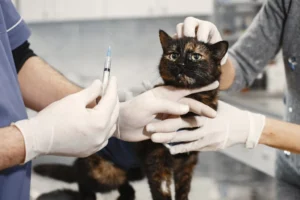Is your Bengal cat constantly on edge and easily startled? Have you noticed them hiding more often or refusing to interact with you? Understanding why your Bengal cat is so scared can help you provide the support and comfort they need to feel safe and secure in their environment. In this blog post, we will explore the potential reasons behind your Bengal cat’s fearfulness and provide tips on how to help them overcome their anxiety.
Understanding Your Bengal Cat’s Behavior
Bengal cats are known for their high energy levels and intelligence, which can sometimes manifest as fear or anxiety. These beautiful felines are naturally curious and playful, but their sharp minds can also make them more sensitive to their environment. If your Bengal cat is displaying signs of fear, it may be due to feeling overwhelmed by their surroundings or a perceived threat. Understanding your cat’s behavior can help you identify the root cause of their fear and address it effectively. Spending time observing your cat’s actions and reactions can offer valuable insights into their emotional state and help you provide the support they need to feel safe and secure in their home environment.
Identifying Triggers for Fear
Various triggers can cause fear and stress in Bengal cats, leading to timid behavior and skittishness. Loud noises, sudden movements, changes in routine, or the presence of unfamiliar people or animals can all contribute to feelings of fear in your feline companion. If you notice your Bengal cat displaying fearful behaviors in response to certain stimuli, take note of these triggers and try to minimize their exposure to them. Creating a calm and predictable environment for your cat can help reduce their anxiety levels and promote a sense of security. Additionally, establishing a routine and providing plenty of opportunities for mental and physical stimulation can help alleviate stress and fear in Bengal cats.
Provide hiding spots: Bengal cats may feel safer when they have a cozy hiding spot where they can retreat to when feeling scared or overwhelmed. Consider setting up a comfortable hiding place in a quiet corner of your home where your cat can escape to when they need a break.
Use pheromone diffusers: Pheromone diffusers, such as Feliway, release calming scents that can help reduce anxiety and stress in cats. Placing a pheromone diffuser in your home, especially in areas where your Bengal cat spends most of their time, can create a more relaxing environment for your furry friend.
Gradual exposure: If your Bengal cat is fearful of certain stimuli, such as new people or loud noises, try desensitizing them by gradually exposing them to these triggers in a controlled and positive way. Start with small exposures and gradually increase the intensity as your cat becomes more comfortable. Rewarding calm behavior with treats or praise can also reinforce positive associations and help your cat overcome their fears. By identifying and addressing the triggers for fear in your Bengal cat, you can help them feel more secure and confident in their surroundings.
Creating a Safe Space for Your Cat
Is your Bengal cat feeling scared and anxious? It’s essential to create a safe environment where they can feel secure. Provide hiding spots, like cozy blankets or cat trees, where they can retreat when feeling overwhelmed. Enrichment opportunities, such as interactive toys or puzzle feeders, can also help reduce stress and boost their confidence. Remember, a calm and welcoming space can make a world of difference for your furry friend.
Building Trust Through Positive Reinforcement
Building trust with your Bengal cat is key to helping them overcome their fears. Positive reinforcement techniques, like offering tasty treats when they display calm behavior or engaging in playtime to bond with them, can strengthen your relationship. It’s essential to respect their boundaries and never force them into a situation that makes them uncomfortable. By approaching them with patience and kindness, you can gradually help them feel more secure and confident.
Unique Insight: One effective way to build trust with your Bengal cat is by using pheromone diffusers or sprays, which can help reduce their anxiety levels and create a sense of comfort in their environment.
- Provide your Bengal cat with a variety of hiding spots to help them feel safe.
- Engage in interactive play sessions to strengthen your bond with your cat.
- Respect your cat’s boundaries and avoid forcing them into situations that make them anxious.
- Consider using pheromone diffusers or sprays to reduce your cat’s anxiety levels and create a calming atmosphere.
Seeking Professional Help
If your Bengal cat is exhibiting excessive fear and anxiety that is significantly impacting their quality of life, it may be time to seek professional help. A behaviorist or veterinarian can provide valuable insights and guidance on how to address your cat’s specific needs. Behavioral therapy can help your cat feel more secure and confident in their surroundings. Remember, seeking professional help is a proactive step towards improving your Bengal cat’s well-being.
Fun Facts About Bengal Cats
Bengal cats are known for their unique traits and behaviors that set them apart from other cat breeds. Did you know that Bengal cats are highly intelligent and curious animals? They thrive on mental stimulation and enjoy interactive play sessions. Additionally, Bengal cats have a love for water and may be found playing in sinks or even joining their owners in the shower! Understanding these fun facts about Bengal cats can help you create a more enriching and stimulating environment for your furry feline friend.
Check out this resource for more information on feline behavior problems and aggression.
Engaging Your Bengal Cat in Play
If your Bengal cat seems scared, engaging them in regular play sessions can work wonders. Playtime not only provides mental and physical stimulation but also helps reduce stress and anxiety. Consider investing in interactive toys like feather wands or laser pointers to keep your furry friend entertained. These toys encourage your cat to pounce, chase, and stalk, mimicking their natural hunting instincts. By incorporating play into their daily routine, you can help your Bengal cat feel more confident and secure in their environment.
Exploring Calming Techniques
When it comes to calming your anxious Bengal cat, it’s essential to explore different techniques to find what works best for them. Consider diffusing calming pheromones in your home, such as Feliway, to create a soothing atmosphere. Additionally, you can create a peaceful environment by providing cozy hiding spots, soft bedding, and soothing music. If your cat’s anxiety persists, you may want to consult your vet about using calming supplements like chamomile or L-theanine. These natural remedies can help alleviate stress and promote relaxation in your beloved Bengal cat.
List of Calming Techniques:
- Diffusing Pheromones: Try using a product like Feliway to create a calming environment for your cat.
- Creating a Soothing Atmosphere: Provide cozy hiding spots, soft bedding, and soothing music to help reduce your cat’s anxiety.
- Utilizing Calming Supplements: Consult your vet about natural supplements like chamomile or L-theanine to promote relaxation in your Bengal cat.
By incorporating these calming techniques into your Bengal cat’s routine, you can help them feel more comfortable and secure in their home.
Supporting Your Bengal Cat’s Emotional Well-being
Creating a Safe Environment: When trying to understand why your Bengal cat is so scared, it’s crucial to create a safe environment for them. Providing hiding spots, cozy spaces, and a consistent routine can help alleviate their anxiety.
Positive Reinforcement: Encourage positive behaviors in your Bengal cat by using treats, toys, and affection. This will help build their confidence and trust in you, ultimately reducing their fear and stress levels.
Slowly Introduce New Stimuli: If your Bengal cat is easily spooked, introduce new stimuli gradually. Whether it’s new people, sounds, or objects, slowly exposing them can help prevent overwhelming situations and decrease their fear response.
Quality Time Together: Spend quality bonding time with your Bengal cat to build a strong relationship. Engage in interactive play, grooming sessions, and cuddle time to show them love and support as they navigate their fears.
Seek Professional Help: If your Bengal cat’s fear and anxiety persist despite your efforts, consider seeking help from a professional veterinarian or animal behaviorist. They can provide tailored advice and strategies to support your cat’s emotional well-being.
Additional Insight: Keep in mind that every Bengal cat is unique, and what works for one may not work for another. Patience and understanding are key as you navigate your cat’s fears and anxieties, ensuring a supportive and loving environment for them to thrive.
Alex, a passionate animal lover, has experience in training and understanding animal behavior. As a proud pet parent to two dogs and three cats, he founded AnimalReport.net to share insights from animal experts and expand his knowledge of the animal kingdom.









